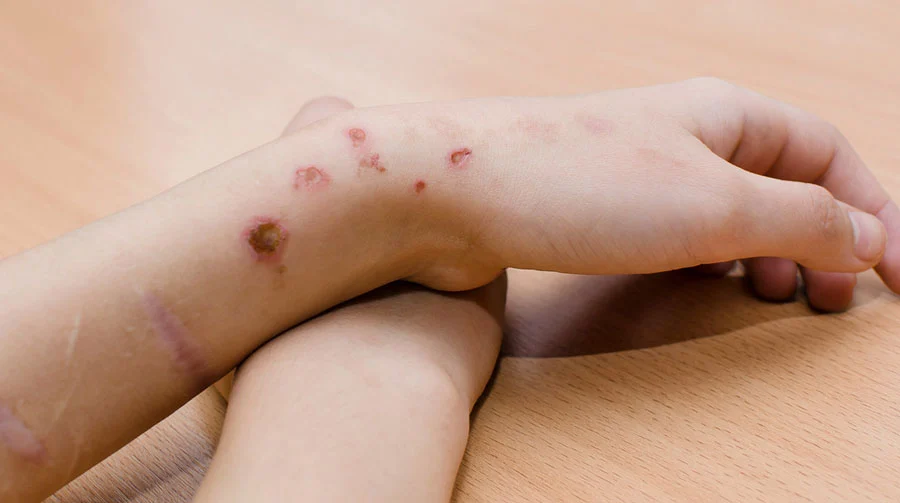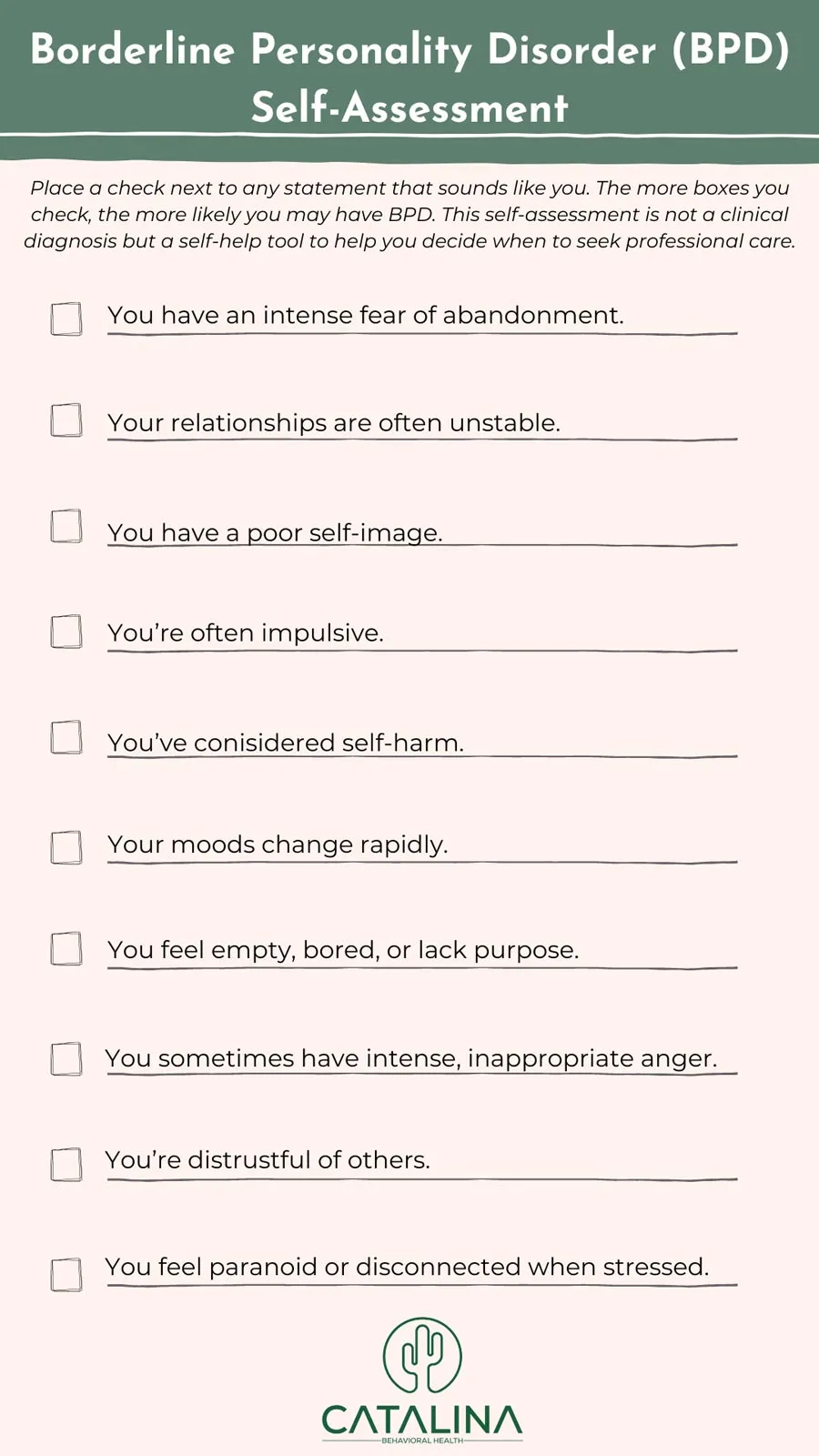An Informal Test for Borderline Personality Disorder Symptoms
If you have found our resource, you may already be well aware of how serious BPD can be.
Borderline Personality Disorder, BPD, is a severe mental health issue that can cause great emotional pain both to the client and their loved ones. The intense emotions and mood swings can be challenging to treat and require the assistance of a licensed mental health professional. Taking an online BPD test can give you a better idea about whether you or someone you love has BPD symptoms, but this self-assessment tool is not a substitute for professional mental health professionals.
Catalina Behavioral Health of Tuscon, Arizona, has experience in treating borderline personality disorder, a cluster B personality disorder. Our professionals can help you or your loved one leave behind emotional instability and form healthy relationships in the future.
Read on to learn more about personality disorders and how to make them more manageable, and remember our caring team is here to offer accredited treatment options for support.
Get Confidential Trauma and PTSD Assessment
What are the Causes of Borderline Personality Disorder?
The exact causes of borderline personality disorder are not fully understood. Many psychological professionals believe it stems from a combination of genetic, environmental, or neurological factors.
For instance, BPD appears to run in families. Some studies have found that the heritability of borderline personality disorder is between 46-49%. These same factors also appear to contribute to loneliness.
Another contributing factor is one’s childhood environment. Those who grow up in a chaotic household or are abused as children appear more likely to develop borderline personality disorder.
Some researchers believe that imbalances of brain chemicals, specifically serotonin, may also play a role in whether someone develops a personality disorder in adulthood.
The Four Core Types of Borderline Personality Disorders

A borderline personality disorder is a mental health condition characterized by unstable emotions, low self-esteem or self-image, and erratic behavior. It is not a choice to “act out,” as some who misunderstand it might think.
Instead, it is among the mental health conditions listed in the Diagnostic and Statistical Manual of Mental Disorders, or DSM-5. Many who have BPD symptoms struggle to maintain healthy relationships and an orderly daily routine.
However, borderline personality disorder is a broad category. There are several sub-types of mental disorders:
1) Impulsive Borderline Personality Disorder
Those who have impulsive BPD tend to be thrill seekers and show marked impulsivity. They have a distorted sense of their invincibility. As a result, loved ones may distance themselves, opting out of watching the self-destructive behavior.
Take ‘TJ,’ a past Catalina client, as an example. TJ had intense and often toxic interpersonal relationships, marked by mood swings. He also switched jobs frequently due to impulsive behaviors and poor decisions. He sometimes smoked weed to chill out.
Unfortunately, smoking weed only further clouded his judgment and made him feel more detached from others. He had never spoken to a licensed mental health professional about his difficulty in relating to others.
A Clinical Assessment Offers a Path Forward for BPD
After an assessment, we were quickly able to identify symptoms of BPD. Our clinical team created a comprehensive treatment plan to help TJ develop impulse control and better emotional regulation. Dialectical Behavior Therapy (DBT) assisted him with learning how to manage his triggers effectively.
That led to a remarkable decrease in impulsive actions. He also learned better communication skills to rebuild relationships.
Today, TJ has a structured day, including morning exercise, a good job, and healthy eating habits. He has quit all forms of substance abuse and enjoys his newfound stability and life more than he ever thought would be possible.
2) Petulant Borderline Personality Disorder

Petulant borderline personality disorder presents with frequent outbursts of frustration or rage, often far out of proportion to the situation. It might also mean passive-aggressive behaviors, unreasonable demands, or the fear of abandonment.
Our client ‘Miriam’ had a daily inner battle against her feelings of anger and dissatisfaction with her life. Her verbal outbursts and passive aggression often pushed people away from her. She had great anxiety about people leaving her; still, her actions pushed them away.
We agreed that Miriam’s primary treatment provider had made an accurate diagnosis – BPD. We offered highly customized treatment options, including Cognitive Behavioral Therapy (CBT), to change her behaviors. We also guided her through anger management techniques to learn other forms of dealing with her frequent dissatisfaction. She learned to communicate better.
Miriam has decided to remain single for now and prioritize her well-being. She looks forward to leaving the pattern of unstable relationships behind.
3) Discouraged Borderline Personality Disorder
Those who have Discouraged Borderline Personality Disorder BPD exhibit behavior that is submissive or co-dependent. They appear clingy and rely on others to reassure them. They may say they feel helpless or inadequate. They have a distorted self-image and often feel tremendously low about their self-worth.
Meet Ana. She came to Catalina expressing feelings of overwhelming worthlessness and stated she often felt some depression. She was in a long-term relationship with Megan; however, Megan was growing tired of Ana’s codependency. Megan made frantic efforts, begging Ana to get treatment; otherwise, the next steps would include a breakup.
Effective Treatment for Co-Occurring Disorders
Ana knew she had a diagnosis of bipolar disorder. However, she was surprised to learn that it could co-occur with BPD. Receiving this formal diagnosis helped get Ana the information – and the help – she needed. Our counselors helped Ana manage her emotions and gave her support as she regained her self-esteem.
Ana flourished in group therapy, gaining valuable insights from other participants. Ana said the BPD diagnosis gave her the missing puzzle piece, helping her regain good mental health. Ana and Megan attended several sessions of therapy together and are rebuilding their relationship.
4) Self-Destructive Borderline Personality Disorder

Those with self-destructive BPD may cut or burn themselves, develop substance abuse or eating disorders, or have suicidal behavior or thoughts. While self-injury can be among the key symptoms of self-destructive borderline personality, no form of self-injury should be downplayed. It is a very high-risk situation, especially when left untreated.
Our past client Patrick often burned himself with cigarettes to express his intense hatred for himself. He was also very impulsive and would often buy drugs from street dealers to numb the reality and intensity of his pain. He came to our clinic as an inpatient after a suicide attempt.
Comprehensive Approaches to Support Self-Harm Clients
We developed a comprehensive treatment program that included DBT and medication management. DBT taught Patrick healthier ways to control his urge to self-harm. In individual therapy, he worked with his therapist to uncover the roots of his emotional pain and started to learn to love himself.
After weeks of intensive therapy, Patrick broke away from his self-destructive patterns. Now, he knows how to handle stress appropriately. He takes life one step at a time and is still working on improving his mental health condition each day, and even beginning to find more peace inside his own skin.
Get Effective Trauma Treatment for BPD
A Short List of Common Borderline Personality Disorder BPD Symptoms
Here are some of the diagnostic criteria to watch for with BPD:
- Fear of abandonment
- Intense and unstable relationships
- Poor self-image
- Impulsive actions
- Consideration of self-harm
- Mood swings, often rapidly
- Feeling a lack of purpose or emptiness
- Inappropriate anger or rage
- Mistrust of others
- Feeling paranoid or disconnected from others when stressed
There may not be a single key symptom; most will have some combination of the criteria outlined.
How Is BPD Diagnosed?

Clinicians can diagnose BPD by conducting a comprehensive assessment. The process usually includes a clinical interview, and an assessment of symptoms, and will also consider other factors such as the client’s mental health and family history.
Several screening tools can help medical professionals make an accurate diagnosis of BPD.
The McLean Screening Instrument (MSI-BPD)
The Mclean Screening Instrument is a self-reporting diagnostic tool. A mental health professional can review the results of the MSI-BPD test and consider it when making a diagnosis.
What are the Most Typical Co-Occurring Disorders With BPD?
As with many mental health disorders, BPD can co-occur with other conditions. Some of the most frequent co-occurrences we have treated include the following:
- Mood disorders (depression, bipolar disorder)
- Anxiety disorders
- Panic disorder or panic attacks
- Post-traumatic stress disorder (PTSD)
- Substance use disorders (drugs or alcohol)
- Eating disorders (anorexia, bulimia)
- Obsessive-compulsive disorder (OCD)
People who live with BPD sometimes have additional complicating disorders. Regardless of the severity of the BPD or co-occurring disorder, the team at Catalina takes a comprehensive, evidence-based approach to treatment.
Take Our Borderline Personality Disorder Test

Mental health disorders, including BPD, require the help of a licensed professional, whether at Catalina or another accredited mental health treatment provider. This borderline personality disorder test is not an official BPD diagnosis. Instead, it gives you a look at some of the symptoms and helps you work through whether your feelings may point to BPD.
If someone is threatening to harm themselves or commit suicide, please call *988 or 911 immediately.
Up To 100% of Rehab Costs Covered By Insurance
Get Accredited Mental Health Treatment Support at Catalina
If you have been diagnosed with BPD or you have BPD symptoms and need help, please give Catalina Behavioral Health a call right away. The symptoms of BPD, or any personality disorder, can be debilitating and life-altering. Catalin offers both residential borderline personality disorder treatment as well as outpatient programs of support.
You or your loved one do not need to live with unchecked symptoms – help is available for your BPD or any co-occurring disorders that you may have along with it.
We ensure your privacy; you have nothing to risk but everything to gain by calling our admissions specialist today.





